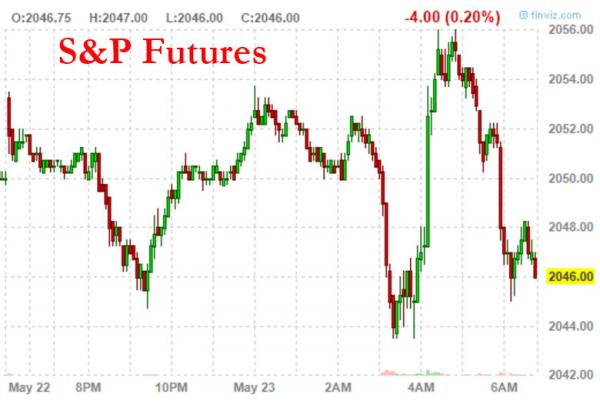Following the latest month abysmal trade and PMI data out of Japan overnight (April exports crashed -10.1 %, worse than the exp. -9.8 and worse than last month’s -6.8% while imports plunged -23.3% also far worse than exp. -18.8 and March -14.9%; PMI 47.6, Exp. 48.3, last 48.2), it was supposed to be a straight up for the USDJPY, and its carry linked E-mini. However, that this did not happen, and instead the Yen jumped, sinking the USDJPY as low as 109.3 was troubling and suggests that the G7 “Sendai discord”, profiled here on Saturday, was worse than even we expected, and Japan indeed no longer has a right to devalue its currency which in turn has pressured the Yen higher.
Aside from Japan, and the previously announced latest mega-M&A in the form of Bayer’s unsolicited $62 billion bid for Monsanto, the overnight session saw various European PMI prints, where despite a miss and drop in the EU Composite PMI (at 52.9, below Exp. 53.2, and last 53.0), Germany reported a modest improvement in its mfg and service PMIs which provided some optimism to the session.
That however does not explain the sharp, sudden swings in the Dax and Stoxx 600, which from opening red, then turning green, were back in the red at last check. Energy companies posted the biggest decline of the equity benchmark’s 19 industry groups as commodities tumbled. Bayer AG lost 3.2 percent after disclosing an unsolicited $62 billion all-cash offer to acquire Monsanto Co. amid investor concern that it might overpay for a deal that would create the world’s biggest supplier of farm chemicals and genetically-modified seeds.
Apple Inc. suppliers AMS AG and Dialog Semiconductor Plc rose at least 2.4 percent, leading a gauge of technology stocks, after Taiwan’s Economic Daily News reported that the iPhone maker has asked suppliers to prepare production for a new version of its smartphones. Aixtron SE jumped 16 percent after the German supplier of semiconductor equipment said it has agreed to a 670 million-euro takeover bid from a group of Chinese investors.
One recurring concern is what the Fed will do, and how this will impact the dollar. As a result, government bonds rose as investors weighed the timing of the Federal Reserve’s next increase in interest rates and the outlook for inflation. As Bloomberg puts it, treasury 30-year yields fell for a third day. The yen rose from near this month’s low, spurred by the biggest trade surplus in six years and a U.S. rebuttal of Japan’s case for intervention to weaken the exchange rate.
Investors are moving to price in the Fed’s first increase in interest rates since December after several policy makers signaled a move is becoming more likely, with Fed Bank of Boston President Eric Rosengren telling the Financial Times at the weekend that he’s ready to back a rate increase. Investors now see a 28 percent chance of a June rate hike, while the chances of a July increase have climbed to 48 percent. Regional Fed chiefs for St. Louis, San Francisco and Philadelphia are due to speak Monday.
“There is a lot of discussion about interest rates in the U.S. and the data we will see this week is important,” Herbert Perus, head of equities at Raiffeisen Capital Management in Vienna, told Bloomberg. “Maybe then we’ll have a better idea of what’s going on in June, July, or September.”
Maybe. Meanwhile, oil fell for a fourth day after Iran said again that it won’t countenance freezing output until its production is back at pre-sanctions levels, while iron ore tumbled on rising Chinese stockpiles and copper declined. The Stoxx Europe 600 Index fell, erasing an advance of 0.4 percent.
Futures on the S&P 500 also declined after initially jumping higher in thinly traded, illiquid tape. Best Buy Co. posts earnings today. Investors are also looking to economic data for indications of the strength of the world’s biggest economy and the trajectory of interest rates. A preliminary report due Monday is forecast to show U.S. manufacturing activity expanded to 51.0 in May, up from 50.8 a month ago.

Market Snapshot
Looking at regional markets, Asian stocks traded mixed despite initially beginning the week mostly higher following last Friday’s tech led-gains in US. Nikkei 225 (-0.5%) underperformed on weak data in which exports and imports fell more than expected highlighting sluggish demand. Japanese exporter sentiment was also pressured by a firmer JPY and contraction in PMI figures. ASX 200 (-0.3%) trades with losses as weakness in copper and oil weighed on sentiment, while Chinese bourses bucked the trend with the Shanghai Comp (+0.6%) & Hang Seng (-0.4%) initially mildly supported after the PBoC continued liquidity injections, coupled with comments from President Xi and Premier Li calling for several measures to support the economy. 10yr JGBs traded mildly higher as the risk-averse sentiment in Tokyo supported safe-haven demand.
China President Xi Jinping called for local authorities to prioritize supply-side reform and increase confidence in economic restructuring, while Chinese Premier Li Keqiang urged for less red tape, improved regulations and better services to support a sustained and healthy development of the economy.









Leave A Comment